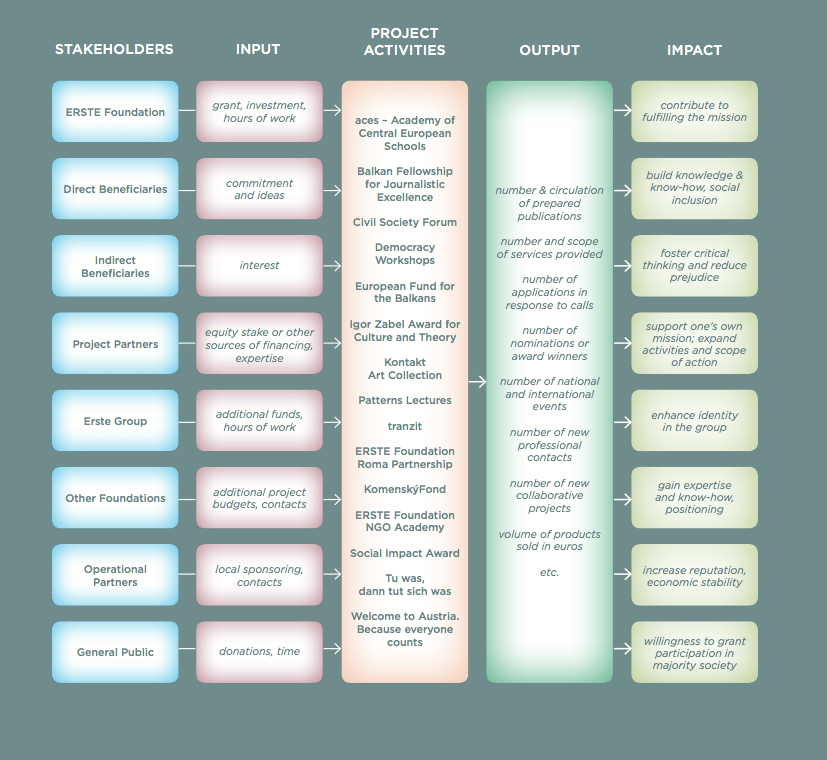What do ERSTE Foundation’s projects and activities achieve? Who benefits from them? What are the specific impacts? Where is ERSTE Foundation particularly effective? A project team in 2016 had these questions in mind as they examined the impact of ERSTE Foundation’s key projects in detail. It was a joint project with the NPO & SE Competence Center of the Vienna University of Economics and Business.
Why is a foundation concerned with impacts in the first place? Social impact and impact measurement are increasingly popular topics. This is due, on the one hand, to the organisational development of non-profit organisations (NPOs) and (social) enterprises. On the other hand, public funding is increasingly contingent on impact-oriented budget management. NPOs, as executive service providers of (semi-)public goods, are increasingly required to prove their effectiveness. Furthermore, foundations, as well as NPOs in general, have to fulfil a specific mission. This mission rarely consists of providing a certain amount of service hours with the minimum of financial outlay.
“Why is a foundation concerned with impacts in the first place?”
Impact-oriented thinking, measuring and possibly even controlling thus defines the core of NPO activities in general and foundations in particular. In addition, it is a question of success, that is whether a deliberately pursued impact is achieved. Which desired objectives or impacts have been achieved and to what extent? This is easier for companies that focus on financial profit. Organisations that do not seek to maximise financial profit but want to contribute added value to society must justify their activities in a more sophisticated way.
How to conduct an impact analysis
Basically, a number of approaches can be taken to thinking of, measuring and assessing impact. The basic approach adopted in the present project was to draw up an impact model that takes into account the various projects and their stakeholders. Stakeholders are interest groups of the organisation that (can) benefit from its assets and must be included in a well-founded impact analysis. Accordingly, the team prepared impact value chains for all stakeholders. A general impact value chain is shown in figure 1. Activities and/or services are carried out by using resources that for the most part include significant financial means. These are usually not an end in themselves but aim to make an impact as defined in the mission. Impact thus results from the services provided. Services precede outcomes and impacts and can be described on the basis of the organisation output that can for the most part be directly appraised or measured.
“Outcome/impact can be intended or unintended.”
Outcome and impact, on the contrary, refers to those positive and/or negative changes found in beneficiaries or involved parties (e.g. people, groups, society) or in the environment after an activity has been completed or a service consumed. If the focus is on outcome/impact, the situation gets even more complex. Outcome/impact can be intended or unintended. If it is intended, i.e. fundamental to the targeted success, the action is planned and goal-oriented. If it is unintended, it may nevertheless be significant and have a positive or even negative influence on the overall outcome of the activities undertaken or services provided.
This is of key relevance in terms of the type and scope of a potential impact analysis. A goal-based approach will only focus on intended outcomes or impacts. In the present case, the focus was on intended, i.e. desired outcomes. Outcomes that would have happened even if ERSTE Foundation had not provided any service – called deadweight – were not fully taken into account.

As each of the 15 included projects has a number of stakeholders, the great complexity of impacts of ERSTE Foundation became apparent early on. The entire complexity was revealed when a finished mind map inclusive of all impact value chains lay spread out on the table at the end of the process. The print-out covered the entire conference table. Individual project managers are now able to use these logically thought-out interdependencies for strategic planning, project-specific impact considerations and their own project-specific impact assessments.
For the foundation as a whole, it was, however, necessary to go a step further to condense data for the sake of clarity. To achieve this, the variety of similar stakeholders were combined in meaningful groups and the numerous individual impacts were clustered into key impact dimensions. In addition, these groups and clusters were prioritised. While this allowed us to maintain the foundation’s diversity, it became easier to observe.

Figure 2 illustrates the impact model for ERSTE Foundation with examples of the condensed and prioritised groups of stakeholders as well as their input and impact. The project activities and the resulting output should be viewed as general services for all stakeholders which the respective impacts result from. Direct beneficiaries do not put in financial resources; instead, they might provide commitment, for example. They benefit from ERSTE Foundation’s activities, as they build up knowledge & expertise and achieve social inclusion, for example.
Not all impacts occur in all projects, and certainly not to the same extent when projects are compared. This is not necessary. What is important is the sum of all impacts: the overall work of art. Future assessments, which have been prepared within the scope of this project, will show how comprehensive these impacts are and to what extent some impacts turn out to be relevant.
In conclusion, it becomes apparent that ERSTE Foundation’s numerous projects have aimed to make a broad range of impacts on a great variety of groups over the past few years. The impact analysis, which is now completed, can help hone its focus and set strategic priorities.
[1] Schober, Christian/Rauscher, Olivia (2014): “Was ist Impact? Gesellschaftliche Wirkungen von (Nonprofit) Organisationen. Von der Identifikation über die Bewertung bis zu unterschiedlichen Analyseformen.”, working paper, NPO&SE Competence Center WU Wien. Download [accessed on 05.01.2017]